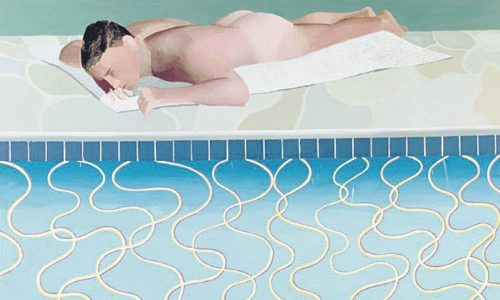Review: David Hockney

This major David Hockney retrospective, the first for 30 years, flits between brilliance and nonchalant mediocrity, with virtuoso paintings hanging metres away from self-cannibalising pastiches of the artist’s best work.
Hockney is the nation’s favourite painter, a national treasure on a level with Alan Bennett, popular enough for The Sun to ask him to redesign its masthead for a day. But that masthead – crudely rendered sunbeams, scrawled like digital graffiti – is a microcosm of his work over the last few decades: garish, clumsy, glib – the antithesis of what made people fall in love with him in the first place.
The vast exhibition – 13 rooms in all – leaves you in no doubt that Hockney’s high-point came during the mid-late 1960s, with works such as A Bigger Splash and The Sunbather and Peter Getting Out of Nick’s Pool; self-contained worlds of abstract swirls and geometric lines, a place of perfect skies and perfect boys with perfect bums that came to define that period in Los Angeles’ history as much as LA defined the young Hockney.
These pieces, as complex and effortless as a waltz, show Hockney’s preoccupation with the divide between the real and the representational, of what is lost and gained when translating an image from three dimensions to two.
It’s something he harks back to with varying success: in photo collages, pasting together hundreds of images to create surreal, flattened landscapes; in videos of a country path in each of the four seasons, nine angled cameras tracking along each one; in digital montages, where he uses a computer to splice pictures together, the scenes lurching uncomfortably under the false perspective.
Hockney essentially plays both artist and curator, his work neatly pigeon-holing itself into more-or-less chronological blocks. There are the early abstractions that feature pop art-esque branding – Alka-Seltzer, Typhoo, Vaseline – combined with mischievous, seductive depictions of gay sex. These images show the artist as a young firebrand, before he mellowed into life in Los Angeles.
Then come the more restrained works painted after his move to Santa Monica, thoughtful and evocative, rightful icons of contemporary art. In the 80s the volume rises and the quality drops, a decline that continues into his more recent paintings of Yorkshire landscapes, which yield only occasional gems such as May Blossom on the Roman Road, with its Triffid-like trees and impressionist sky.
We finish with his iPad paintings, which play on a looped video showing their creation from first stroke to last. They’re the kind of thing you might find if you searched YouTube for “how to paint like David Hockney” – it’s an unfortunate way to end an exhibition that contains paintings of such enormous worth.
Volume works against the artist here. His best pieces draw attention to the worst; I certainly didn’t have such a strong reaction to his Yorkshire and iPad paintings when they were collected in isolation.
Viewing his career en masse, it’s clear Hockney has never escaped from his own long shadow, one cast by the high LA sun, glinting seductively on a swimming pool, the surface broken by the dive of a beautiful young man. There are worse places to be stuck.
First published in City A.M.

